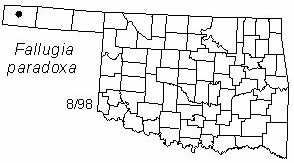Clump-forming shrub to 2.5 m (8 ft), usually smaller in Oklahoma. Bark white to dark gray. Twigs white, pubescent. Leaves alternate, simple, cuneate-obovate or spatulate with 3 - 7 deep lobes, 0.6-1.3 cm (0.25-0.5 in) long, tomentose beneath, attenuate at base, obtuse at apex, entire, revolute. Flowers solitary on long peduncles or corymbose, 1.9-2.5 cm (0.8-1 in) long; calyx cupulate with ovate lobes; petals 5, white, slender, hairy; flowers appear June to August. Fruits clusters of numerous achenes tipped with a persistent style that is feathery and reddish in color; seeds hairy and solitary.
Distribution: occurs in California, Texas, New Mexico, Colorado, Utah, Nevada, also Mexico. Rare in Oklahoma; restricted to northwestern Cimarron County.
Habitat : dry, rocky slopes and arroyos.
NWI status: none
Comments: Fallugia is named in honor of Virgilio Fallugi, a seventeenth century Italian botanist; paradoxa refers to the plant's paradoxical resemblance to a rose. Browsed by cattle and decreases in abundance with heavy grazing.
Horticulture: grown ornamentally for the unique fruits. Prefers moist soil.
Medicinal uses: The Hopi used a leaf infusion as a hair growth stimulant.
Distribution in Oklahoma: 
BACK
NEXT
RETURN TO INDEX
Last update: 9/10/99
 Go to Oklahoma Biological Survey Home Page
Go to Oklahoma Biological Survey Home Page
 Disclaimer
Disclaimer